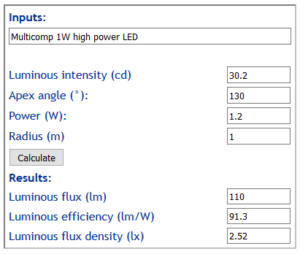Browsing eBay for some high power LEDs for a current project created frustration in trying to wade through the stated performance figures (to they extent that they can be relied upon).
LEDs are often headlined as having some luminous intensity in candelas, but while that might seem to be a good measure of the ‘brightness’ of the LED viewed on-axis, it gives no information about the spatial distribution off-axis and the total luminous flux output or flux density.
I wrote a little online calculator that can be of assistance in finding the total luminous flux and flux density give luminous intensity and apex angle, Calculate luminous flux (lm) from luminous intensity (cd) and apex angle (°). (Note that specified luminous intensity is usually on axis and should be discounted by perhaps 20% to provide an average luminous intensity over the cone angle.)
Example 1
An example, an eBay seller advertises:
Specifications:
Source Material: InGaN !
Emitting Colour: 0.5W 10MM HI POWER White 0.5W LED
LENS Type: Water clear
Luminous Intensity-MCD: Typ: 290,000 mcd
Reverse Voltage: 5.0 V
DC Forward Voltage: 3.2 ~ 3.4V
DC Forward Current: 100mA
Viewing Angle: 40 degree
Lead Soldering Temp: 260¡ãC for 5 seconds
Power Dissipation: 500mW
Does it appear rational? Lets calculate average luminous intensity at 80% of 290cd, 232cd. Lets assume the viewing angle is the half power beamwidth.
Above is a calculation from the specifications. Of concern is the calculated luminous efficiency of 266lm/W, it is perhaps three times or more the expected value, so it questions the accuracy of the claims. Even at 0.5W input, the luminous efficiency is unrealistically high.
Example 2
From the Multicomp datasheet:
Above, the luminous efficiency is realistic, the apex angle is the half power beamwidth taken from the polar pattern. Luminous efficiency is realistic.

